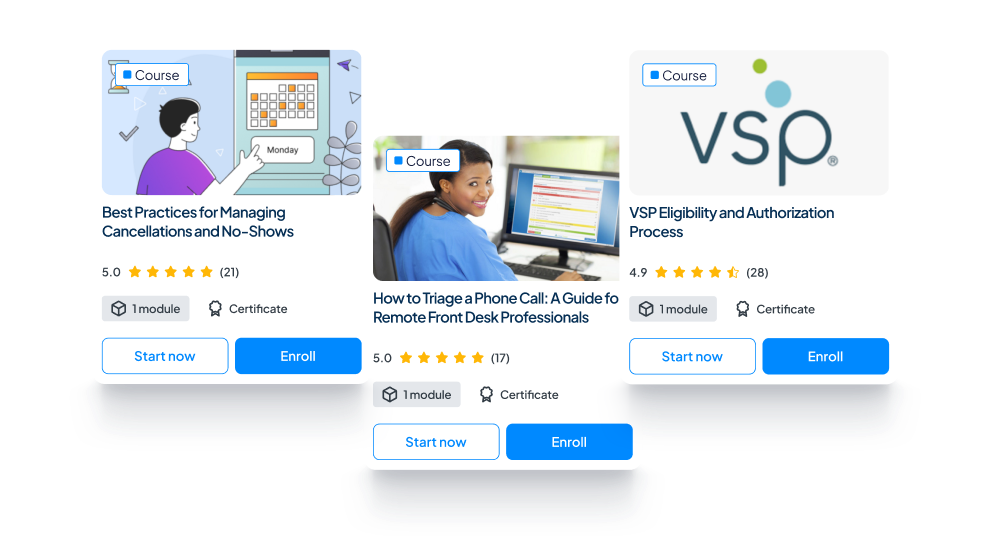Key Takeaways
-
Optometry practices in 2025 face growing pressure from rising costs, staff burnout, and higher patient expectations.
-
Traditional hiring models no longer meet today’s demands, leading practices to adopt hybrid teams that combine in-office and remote support.
-
Virtual Assistants are becoming essential in managing scheduling, insurance, billing, and scribing with greater efficiency and accuracy.
-
Hybrid teams enable doctors and staff to focus on patient care while VAs handle administrative tasks that often slow clinics down.
-
Practices using Virtual Assistants experience fewer missed calls, more booked appointments, and improved patient satisfaction.
-
Replacing turnover-prone roles with trained VAs helps reduce costs by up to 50 percent while maintaining consistency and reliability.
-
Case studies demonstrate clear ROI, including better scheduling coverage, reduced burnout, and measurable revenue growth.
-
The future of optometry is hybrid, combining clinical excellence with operational efficiency powered by virtual support.
In 2025, optometrists face a new reality: patients expect more, margins are tighter, and reliable staff are harder to find. The practices thriving this year aren’t just hiring faster; they’re restructuring smarter. Across the country, forward-thinking eye care practices are leveraging Optometry Virtual Assistants (VAs) to handle critical administrative tasks, stabilize operations, and deliver a better patient experience.
Let’s explore how Virtual Assistants are helping optometrists redesign their teams for efficiency, profitability, and peace of mind.
The Changing Landscape of Optometry in 2025
The business of eye care has shifted dramatically since the pandemic. Costs continue to climb, rent, software, supplies, and wages, while insurance reimbursements remain stagnant. Meanwhile, burnout and turnover are at all-time highs.
Many practices owners report spending as much time managing their business as they do seeing patients. Recruiting, training, and retaining reliable staff has become a full-time job, pulling optometrists away from what matters most, patient care.
At the same time, administrative workloads keep rising. Missed calls, delayed insurance verifications, and backlogged documentation can quietly erode both patient satisfaction and profitability.
The solution isn’t simply to “hire more.” It’s to reimagine how the work gets done.
The Strategic Shift: Restructure, Don’t Just Rehire
In today’s environment, the old staffing model no longer works. The fastest-growing optometry practices aren’t just replacing employees; they’re restructuring their teams to balance in-office excellence with remote efficiency.
The Rise of the Hybrid Team
A hybrid optometry team blends your in-practice staff, focused on face-to-face patient care, with highly trained Virtual Assistants who manage time-consuming administrative work remotely.
Typical hybrid model:
- In-office team greets patients, assists with optical sales, supports exams.
- Virtual team: manages phone calls, scheduling, insurance verifications, billing follow-ups, and scribing.
This balance allows practices to operate with the agility of a large organization, without the overhead.
Proof in Practice
Across the U.S., optometry practices using hybrid staffing are seeing measurable improvements: fewer missed calls, more appointments scheduled, shorter billing cycles, and happier staff.
When each role, clinical, front desk, and administrative, is supported properly, efficiency follows naturally.
How Virtual Assistants Drive Efficiency and Growth
1. Front-Desk Coverage and Call Management
Missed calls equal missed opportunities. A dedicated VA can:
- Answer calls promptly during busy patient hours.
- Handle confirmations and reschedules.
- Reduce no shows and increase filled appointments.
Practices using Virtual Assistants report higher patient retention and more new patient bookings within the first 60 days.
2. Insurance Verification and Revenue Cycle Support
Insurance checks, eligibility calls, and denied-claim follow-ups can consume hours each day. VAs trained in EHR systems like Revolution, Crystal PM, or Compulink can manage:
- Eligibility verification before patient visits.
- Claims resubmission and follow-up.
- Patient balance outreach.
This ensures steady cash flow and frees your in-office team to focus on service and sales.
3. Medical Scribing and Documentation
Every OD knows how draining documentation can be. An optometry virtual scribe allows doctors to:
- Spend more time engaging patients.
- Increase exams per day.
- Improve accuracy and compliance.
With scribing support, practices can increase efficiency while delivering more attentive patient care.
4. Back-Office Administration
From patient billing to contact-lens orders, VAs handle repetitive administrative tasks efficiently and consistently, improving the patient experience while reducing staff stress.
Real ROI: Profitability and Patient Experience
More Efficiency, More Revenue
When administrative tasks are managed by reliable VAs, the entire practice runs smoother. Calls are answered, claims are processed faster, and the front desk has time to deliver better in-office service.
The financial result? Lower labor costs, fewer missed appointments, and higher overall productivity.
Reduced Costs, Increased Margins
The average front-desk healthcare role in the U.S. costs thousands per month once you factor in wages, payroll taxes, and benefits.
A highly skilled Teem VA costs roughly half that, saving practices up to $24,000 per year, funds that can be reinvested into growth or team development.
Enhanced Patient Experience
When staff aren’t overwhelmed by phones and paperwork, they can focus on patients. That means better chairside care, improved reviews, and stronger referrals, a true competitive advantage in 2025.
Why Teem’s Approach Works
Not all virtual staffing services are created equally. Teem’s success with optometry practices comes from three key pillars.
1. Smart Hiring
Teem uses a proprietary recruiting system that evaluates education, English proficiency, cultural fit, and reliability, ensuring every hire is custom matched to the practice’s needs.
2. Teem University Training
Every VA receives role-specific training in optometry workflows, EHR systems, and patient communication.
At the same time, practices receive onboarding guidance on how to successfully integrate and manage a remote team member.

3. Real-Time Visibility and Support
Teem provides tools that help practices monitor:
- Calls answered and tasks completed.
- Productivity aligned with KPIs.
- Transparent time management and performance reports
This clarity drives accountability, retention, and measurable results.
The Future of Optometry Teams: Hybrid, Scalable, Sustainable
The most profitable practices in 2025 will be hybrid teams, combining on-site staff with reliable remote professionals who share the same mission and values.
The benefits are clear:
- Lower burnout across the team.
- Consistent patient coverage without staffing gaps.
- Scalable growth as demand increases.
- Improved margins despite rising costs.
As technology evolves and patient expectations rise, hybrid staffing isn’t a short-term fix, it’s the future of sustainable practice management
Ready to Restructure Your Practice for the Future?
If you’re ready to scale your optometry practice efficiently, without sacrificing care quality or sanity, Teem can help.
Our Virtual Assistants are:
- Healthcare-trained and HIPAA-compliant.
- Fluent in English (and often Spanish).
- Hand selected to fit your team’s culture and workflow.
If you’re ready for support that actually saves you time, reach out to Teem HERE.



